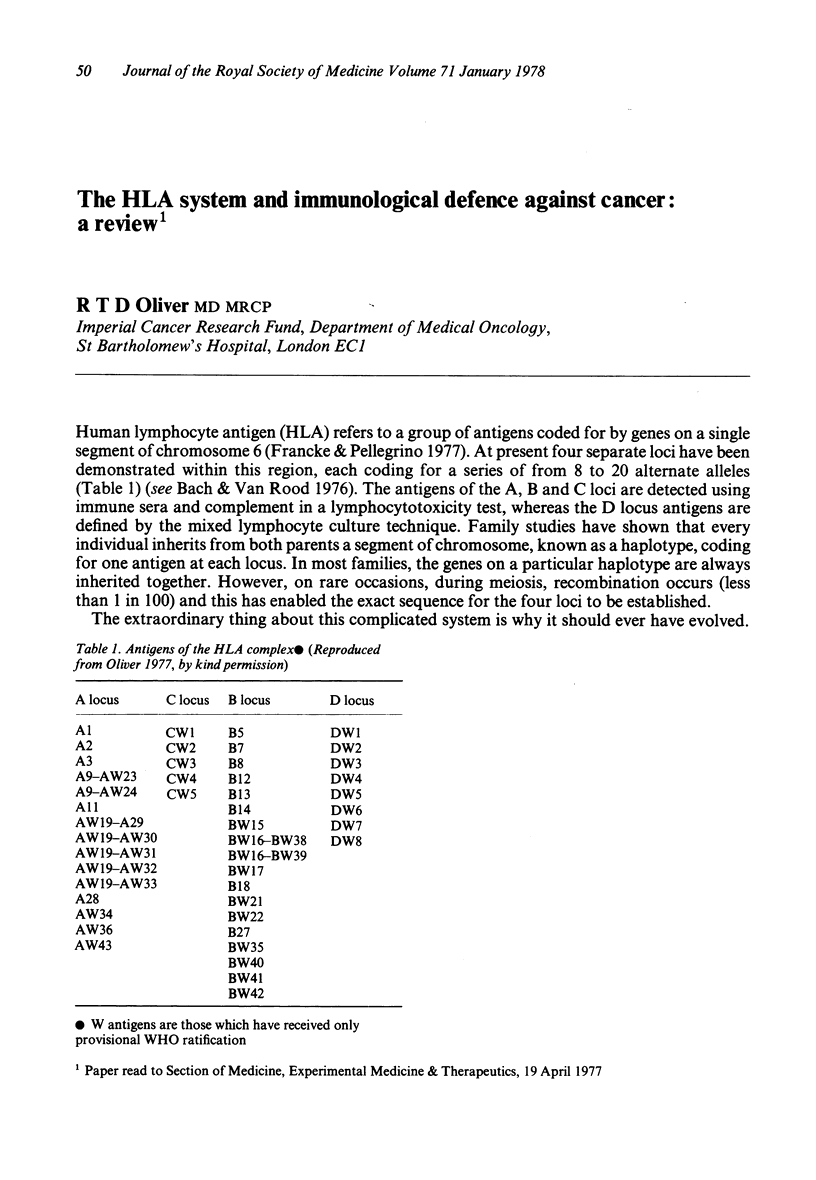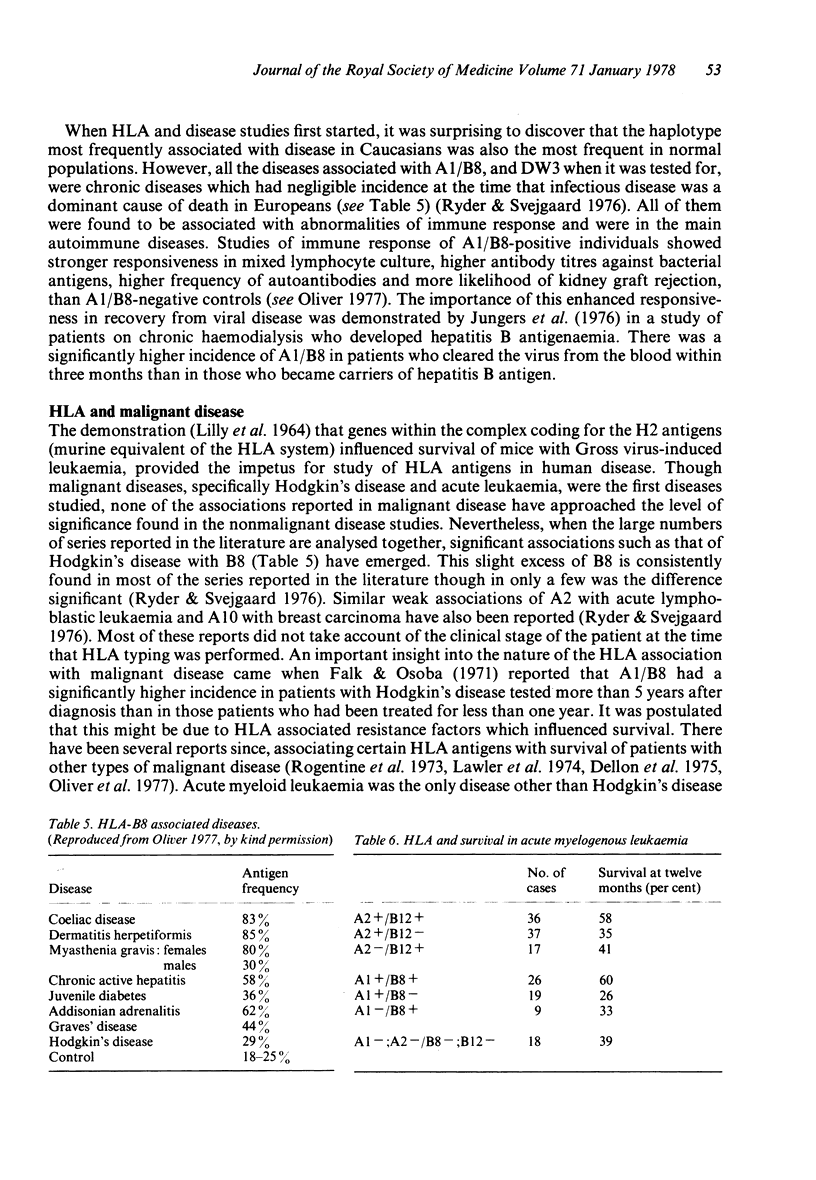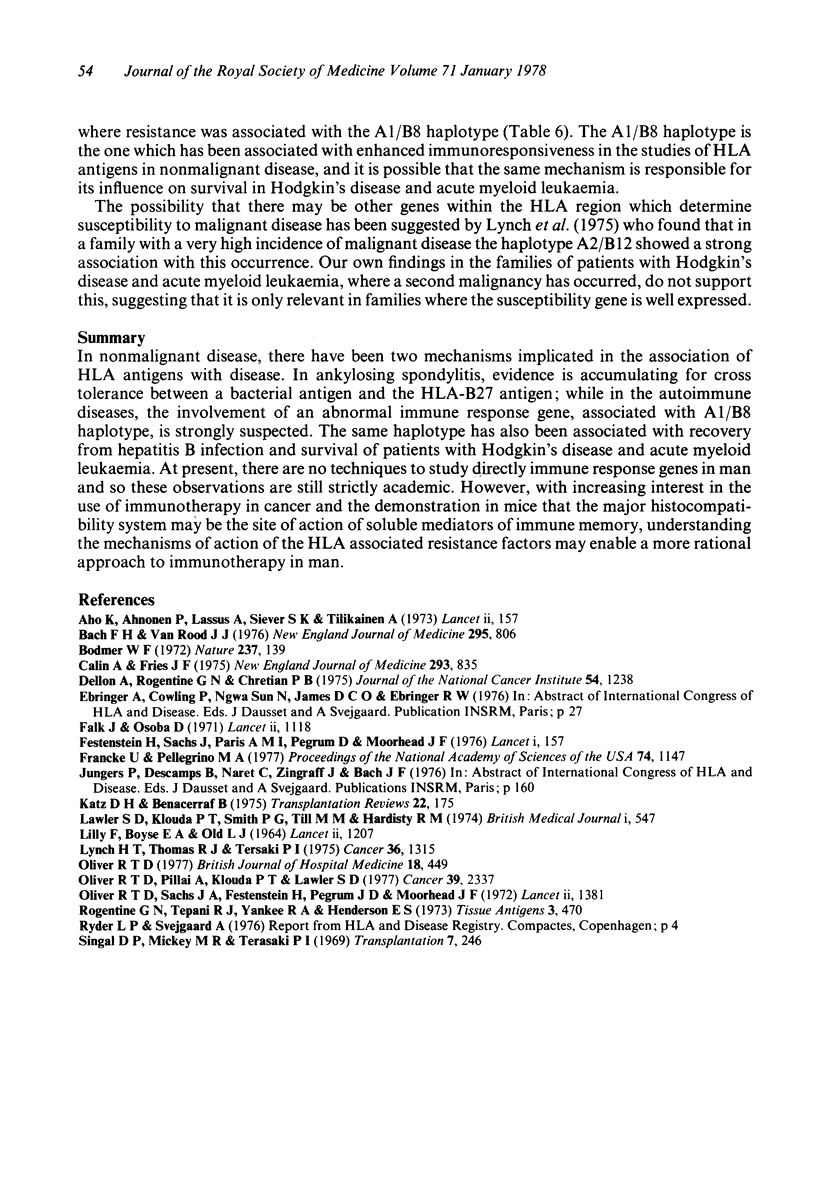Abstract
In nonmalignant disease, there have been two mechanisms implicated in the association of HLA antigens with disease. In ankylosing spondylitis, evidence is accumulating for cross tolerance between a bacterial antigen and the HLA-B27 antigen; while in the autoimmune diseases, the involvement of an abnormal immune response gene, associated with A1/B8 haplotype, is strongly suspected. The same haplotype has also been associated with recovery from hepatitis B infection and survival of patients with Hodgkin's disease and acute myeloid leukaemia. At present, there are no techniques to study directly immune response genes in man and so these observations are still strictly academic. However, with increasing interest in the use of immunotherapy in cancer and the demonstration in mice that the major histocompatibility system may be the site of action of soluble mediators of immune memory, understanding the mechanisms of action of the HLA associated resistance factors may enable a more rational approach to immunotherapy in man.
Full text
PDF




Selected References
These references are in PubMed. This may not be the complete list of references from this article.
- Aho K., Ahvonen P., Lassus A., Sievers K., Tilikainen A. HL-A antigen 27 and reactive arthritis. Lancet. 1973 Jul 21;2(7821):157–157. doi: 10.1016/s0140-6736(73)93109-7. [DOI] [PubMed] [Google Scholar]
- Bach F. H., van Rood J. J. The major histocompatibility complex--genetics and biology. (First of three parts). N Engl J Med. 1976 Oct 7;295(15):806–813. doi: 10.1056/NEJM197610072951504. [DOI] [PubMed] [Google Scholar]
- Bodmer W. F. Evolutionary significance of the HL-A system. Nature. 1972 May 19;237(5351):139–passim. doi: 10.1038/237139a0. [DOI] [PubMed] [Google Scholar]
- Calin A., Fries J. F. Striking prevalence of ankylosing spondylitis in "healthy" w27 positive males and females. N Engl J Med. 1975 Oct 23;293(17):835–839. doi: 10.1056/NEJM197510232931701. [DOI] [PubMed] [Google Scholar]
- Falk J., Osoba D. HL-A antigens and survival in Hodgkin's disease. Lancet. 1971 Nov 20;2(7734):1118–1120. doi: 10.1016/s0140-6736(71)91272-4. [DOI] [PubMed] [Google Scholar]
- Festenstein H., Sachs J. A., Pegrum G. D., Moorhead J. F., Paris A. M. Influence of HLA matching and blood-transfusion on outcome of 502 London Transplant Group renal-graft recipients. Lancet. 1976 Jan 24;1(7952):157–161. doi: 10.1016/s0140-6736(76)91270-8. [DOI] [PubMed] [Google Scholar]
- Francke U., Pellegrino M. A. Assignment of the major histocompatibility complex to a region of the short arm of human chromosome 6. Proc Natl Acad Sci U S A. 1977 Mar;74(3):1147–1151. doi: 10.1073/pnas.74.3.1147. [DOI] [PMC free article] [PubMed] [Google Scholar]
- Katz D. H., Benacerraf B. The function and interrelationships of T-cell receptors, Ir genes and other histocompatibility gene products. Transplant Rev. 1975;22:175–195. doi: 10.1111/j.1600-065x.1975.tb01559.x. [DOI] [PubMed] [Google Scholar]
- LILLY F., BOYSE E. A., OLD L. J. GENETIC BASIS OF SUSCEPTIBILITY TO VIRAL LEUKAEMOGENESIS. Lancet. 1964 Dec 5;2(7371):1207–1209. doi: 10.1016/s0140-6736(64)91043-8. [DOI] [PubMed] [Google Scholar]
- Lawler S. D., Klouda P. T., Smith P. G., Till M. M., Hardisty R. M. Survival and the HL-A system in acute lymphoblastic leukaemia. Br Med J. 1974 Mar 23;1(5907):547–548. doi: 10.1136/bmj.1.5907.547. [DOI] [PMC free article] [PubMed] [Google Scholar]
- Lynch H. T., Thomas R. J., Terasaki P. I., Ting A., Guirgis H. A., Kaplan A. R., Magee H., Lynch J., Kraft C., Chaperon E. HL-A in cancer family "N". Cancer. 1975 Oct;36(4):1315–1320. doi: 10.1002/1097-0142(197510)36:4<1315::aid-cncr2820360419>3.0.co;2-t. [DOI] [PubMed] [Google Scholar]
- Oliver R. T. Histocompatibility antigens and human disease. Br J Hosp Med. 1977 Nov;18(5):449-52, 457-9. [PubMed] [Google Scholar]
- Oliver R. T., Pillai A., Klouda P. T., Lawler S. D. HLA linked resistance factors and survival in acute myelogenous leukemia. Cancer. 1977 Jun;39(6):2337–2341. doi: 10.1002/1097-0142(197706)39:6<2337::aid-cncr2820390603>3.0.co;2-x. [DOI] [PubMed] [Google Scholar]
- Oliver R. T., Sachs J. A., Festenstein H., Pegrum G. D., Moorhead J. F. Influence of HL-A matching antigenic strength, and immune responsiveness on outcome of 349 cadaver renal grafts. 3 years' experience of the London transplant group. Lancet. 1972 Dec 30;2(7792):1381–1385. doi: 10.1016/s0140-6736(72)92961-3. [DOI] [PubMed] [Google Scholar]
- Rogentine G. N., Trapani R. J., Yankee R. A., Henderson E. S. HL-A antigens and acute lymphocytic leukemia: the nature of the HL-A2 association. Tissue Antigens. 1973;3(6):470–476. doi: 10.1111/j.1399-0039.1973.tb00517.x. [DOI] [PubMed] [Google Scholar]
- Singal D. P., Mickey M. R., Terasaki P. I. Serotyping for homotransplantation. 23. Analysis of kidney transplants from parental versus sibling donors. Transplantation. 1969 Apr;7(4):246–258. [PubMed] [Google Scholar]


